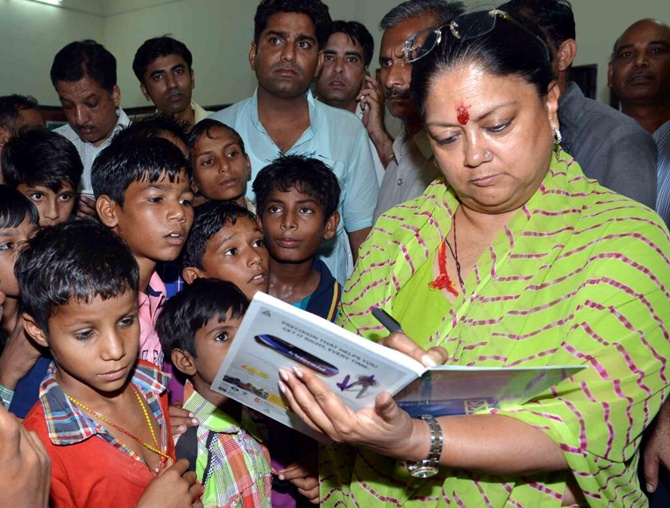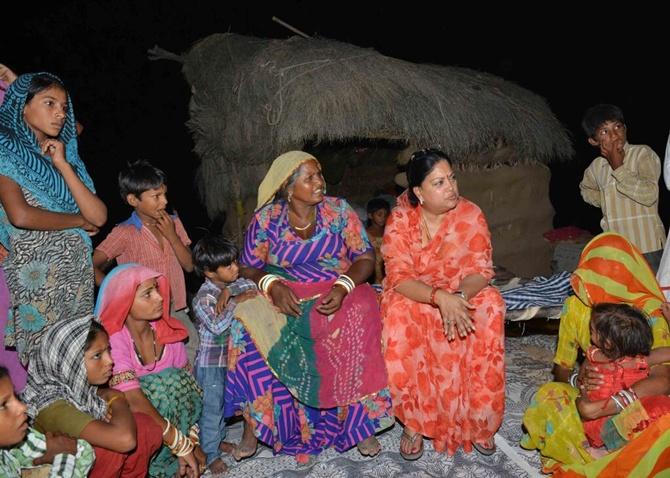Photographs: Courtesy, Vasundhara Raje's Twitter page Arvind Panagariya
Vasundhara Raje is pioneering the 'Rajasthan Model', which places policy reform at the centre of the development strategy, says Arvind Panagariya.
Bihar, Chhattisgarh, Gujarat and Odisha, which have all delivered excellent growth and development outcomes for their citizens during the last decade, have one thing in common: they all have had chief ministers who provided generally clean and transparent administration and effective implementation of infrastructure projects and social schemes.
Policy reforms that economists often advocate were not a major part of their strategy. In areas covered by the Union and Concurrent Lists of the Constitution, these states took as given the laws enacted by the central government.
And in areas included in the State List, with rare exceptions such as the agricultural produce marketing committees Act and the repeal of the urban land ceilings Act, no new legislative actions were taken.
Vasundhara Raje Scindia, the chief minister of Rajasthan, is now breaking that mould.
She is pioneering what may be called the "Rajasthan Model", which places policy reform at the centre of the development strategy.
...
Vasundhara Raje's 'Rajasthan Model' set to be a success
Photographs: Courtesy, Vasundhara Raje's Twitter page
She has begun with a bang - reforms of many laws on the Concurrent List that are crucial to the growth of employment-intensive sectors, such as apparel, footwear and electronic assembly, and that the Centre seems reluctant to touch.
Ms Raje explicitly contested her December 2013 election on the platform of empowerment through job creation over dole, and scored a spectacular victory. She won more than 80 per cent of the seats in the Rajasthan legislative assembly.
She then took the same message to her people, alongside the Bharatiya Janata Party (BJP)'s prime ministerial candidate Narendra Modi, and delivered an unprecedented 25 out of 25 parliamentary seats from Rajasthan.
These major political missions accomplished, Ms Raje is now poised to lead Rajasthan to the path of development, growth and jobs.
Like other successful chief ministers, she recognises the importance of effective governance and implementation of projects and schemes.
What distinguishes Ms Raje from her peers, however, is the importance she places on economic policies as engines of growth and job creation.
…
Vasundhara Raje's 'Rajasthan Model' set to be a success
Image: Vasundhara Raje with Prime Minister Narendra Modi.Photographs: Courtesy, Vasundhara Raje's Twitter page
In this, she is even ahead of states such as Gujarat and Tamil Nadu, which have both seen industry flourish - but with limited job creation since the successful sectors have been highly capital-intensive.
To break this pattern and facilitate growth that would bring jobs to workers with limited skills, Ms Raje has begun her second term as chief minister (she previously headed the Rajasthan government from 2003 to 2008) with the reform of the key labour laws that economists widely see as obstacles to the development of the labour-intensive industry.
Amendments to three key laws - the Industrial Disputes Act, the Factories Act of 1948 and the Contract Labour (Regulation and Abolition) Act - were the first to clear the Cabinet.
The next came amendments to the Apprentices Act and relaxations in the Boilers Act. On 31 July, 2014, the Rajasthan Assembly passed the amendment Bills. The latter will now go to the central government for assent of the president before becoming law in Rajasthan.
…
Vasundhara Raje's 'Rajasthan Model' set to be a success
Photographs: Courtesy, Vasundhara Raje's Twitter page
The significance of the proposed reforms can be hardly understated, for their substance as well as their symbolism.
Substantively, the reforms expand the space for entrepreneurs who want to employ workers rather than machines for every possible task.
I have often said that the tyranny of labour laws in India has meant that entrepreneurs have avoided touching workers even with a 10-foot pole, opting instead for machines to perform every conceivable task.
The proposed reforms will open the door significantly wider to the employment of workers.
Symbolically, the reforms show yet again that the action in India has very much shifted to the states.
A bold and imaginative chief minister is driving reforms that the central government, with its massive majority in the Lok Sabha, could introduce at one stroke in the entire nation.
But so far, the central government has kept a low profile on these reforms - except in the case of the relatively non-controversial Apprentices Act.
…
Vasundhara Raje's 'Rajasthan Model' set to be a success
Photographs: Courtesy, Vasundhara Raje's Twitter page
According to a key provision in the Industrial Disputes Act, slated for reform by the Raje government, a factory employing 100 workers or more must seek the permission of the state government to lay off any worker, under any circumstances. Because state governments are reluctant to grant such permission, the law effectively turns into an insurmountable barrier to worker layoffs under all circumstances.
In turn, this situation discourages factories from growing beyond 100 workers. And even when they must grow large, as in the automobile or machinery sectors, they opt for the most capital-intensive technologies.
The amendment proposed by the Rajasthan government raises the threshold at which the law kicks in from 100 to 300 workers.
It is astonishing that Indian laws view a factory of 100 workers as a large, corporate firm. In the United States, any firm with fewer than 250 workers is classified as "small", while a firm with 250 to 500 workers is classified as "medium".
…
Vasundhara Raje's 'Rajasthan Model' set to be a success
Image: Vasundhara Raje with Prime Minister Narendra Modi.Photographs: Courtesy, Vasundhara Raje's Twitter page
Even the World Bank, a development institution, defines a firm with 50 to 300 workers as being of medium size, and not large.
Given that dynamism in an economy comes from small and medium size upstart firms trying to become large to challenge the dominant incumbent firms, it is ironic that our laws should effectively suppress such dynamism by discouraging them from growing beyond 100 regular workers.
Ranked second from the bottom in 1980-81 according to per capita income, Rajasthan has performed well in recent decades.
It ranks above Assam, Madhya Pradesh and Uttar Pradesh, and is no longer a "Bimaru" state. But it does not yet count among the fastest growing states.
This is about to change, however, under the dynamic leadership of Ms Raje and her equally dynamic and reform-minded chief secretary, Rajiv Mehrishi.
With the key reforms likely to be in place in the first two years of her term, the chief minister can count on harvesting a bumper crop by the time the next election comes around.
The writer, a professor of economics at Columbia, who was recently appointed the vice-chairman of the Rajasthan Chief Minister's Economic Advisory Council, makes no claims to the reforms described in this article.








article